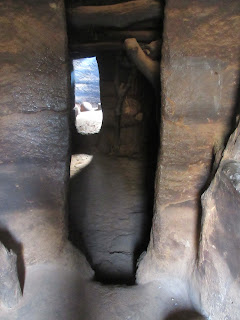 |
| Riding the bus north we saw lots of cotton coming the opposite way. |
After a few days in Cotonou and Ouidah, we took a bus to
Natitingou, one of northern Benin’s largest towns. A tour of the surrounding
area allowed us to see traditional dwellings, and we learned about the blend of
Islamic belief and local culture too.
Compared to other countries we have visited, Beninois are
quite open about the blending of traditional beliefs with those adopted from
Christianity and/or Islam. Their syncretism is very accommodating to a range of
practices – well, mostly. Leaving Natitingou for points south, the other
occupants in our taxi engaged in a one-sided diatribe against people who
believed in strict observance of religious practices. The residents of Djougou
came in for particular criticism, as a town where most Muslims followed Islam
without incorporating local practices.
 |
| Exterior and ground floor of a tata somba (house/compound). Animals are kept inside on the ground floor overnight. Tata sombas are surrounded by talismans and altars to traditional deities. |
An example of how Beninois combine religious and cultural
practices to their liking was shared by a Peace Corps volunteer we met in
Natitingou who was based near Boukoumbe. After observing Ramadan, the residents
celebrated Eid al Fitr with an all-day binge on tchoukoutou (millet beer).
 |
| View of granary on the upper floor of the compound. |
Our walking tour in the around Boukoumbe and Koussoukoingou allowed us to see tata sombas, traditional fortified housing of the area. The compounds were constructed with living quarters and grain storage on the higher floor, while the ground floor was reserved for livestock and cooking. Pulling ladders up helped keep the homestead secure. There were also holes in the compound head’s room to observe what’s happening outside (arrows could also be shot out of the holes).
 |
| Second floor (first European) of a tata somba: granary (left) with ladder, bedroom (right). |
The second tata somba we visited was Tata Osiri (our guide Prosper’s ethnic group). There was one level above the ground floor. The roof had four granaries – including one for guests and one for the very old or infirm. The host offered a benediction in Osiri for Blair’s broken arm.
The Nere tree was pointed out to us. The seed pods contain
yellow powder used in pate/sauce and drinks. The seeds are pounded to make a
type of mustard (that smells bad but tastes good). The seed pod is boiled then
used to reinforce the mud of the tata sombas.
 |
| Natitingou's main street at dusk. |
 |
| Huts near Kota Falls. They were used by fighters in the Kaba rebellion against French rule. |
Later, Jean and Prosper pointed out that the colonial road
had been surrounded by mango trees so that the colonists could find it. It
seemed ridiculous but now we have more mangoes. It’s the same as with the
schools…
We also visited Kota Falls, which was also the sight of the
Kaba rebellion (named after its leader) against the French from 1915-1917. The
area had remnants of huts where the fighters hid. We closed out our stay in Natitingou with some tchoukoutou
at a “cabaret” (millet beer bar) next to the Natitingou Regional Museum.
 |
| Natitingou Regional Museum and the "cabaret" around the back with calabashes and holders for millet beer. |

















![Expat [DESTINATIONCOMPLETE]](http://www.expat.com/logo/expatBlogSmall.gif)
No comments:
Post a Comment